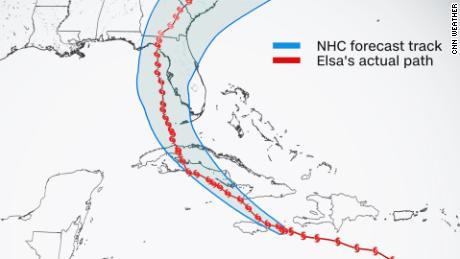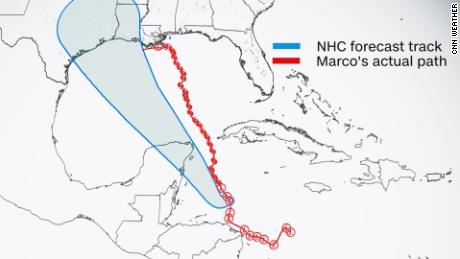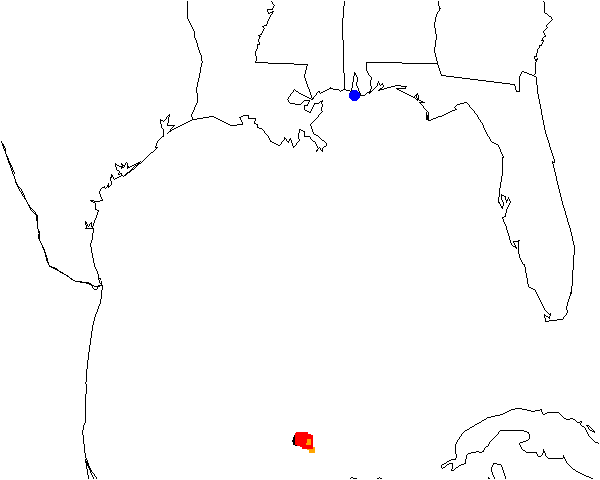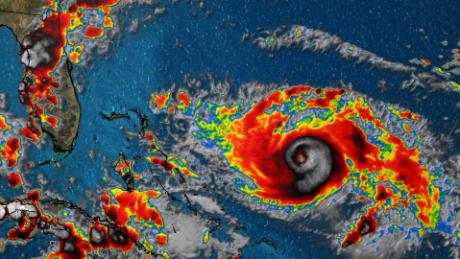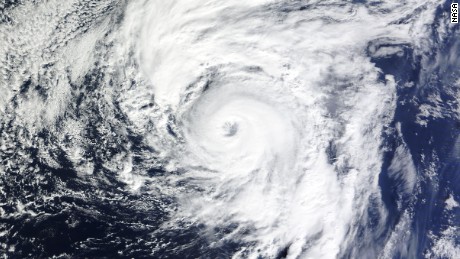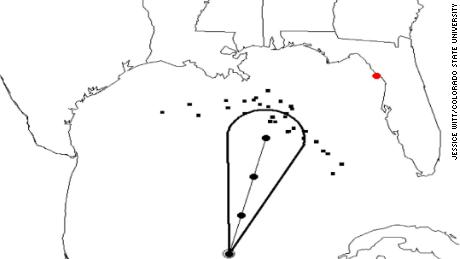(CNN)The most used and looked at graphic when a hurricane is forecast could be unintentionally misleading the public into perceiving that they could be safe from a hurricane's track and impacts.
The graphic in question is the track of the hurricane issued by the National Hurricane Center, but even more specifically the track forecast cone -- colloquially known as the "cone of uncertainty."
The cone represents the probable track of the center of a tropical system and extends up to five days in 12-hour increments, according to the hurricane center.
Even though the center of a storm remains within the cone 60 to 70% of the time, according to data from the hurricane center over the last five years, the effects of tropical storms and hurricanes often extend much farther than this defined boundary.
Now, researchers at Colorado State University (CSU) may have come up with a better way to inform the public about hurricanes to help keep them safe.
It is all about perspective
The problem stems from how people perceive the boundaries of the track forecast cone.
In general, people perceive areas that are highlighted within the cone as "at risk" and areas that are outside of the cone as being "safe." Researchers refer to this perceived notion as the "containment effect."
"The most common misunderstanding about the cone of uncertainty is the border of it," said Brian McNoldy, a senior research associate at the University of Miami's School of Marine and Atmospheric Science. "People see it and think that being inside the cone is bad, and outside the cone is fine. That is most definitely not the intended message."
The intended message of the track forecast cone is to show where the center of the storm could be over the next five days. Statistically speaking, the longer the forecast period, the more room for error exist. The cone is much wider five days out than just 24 hours out to account for this error.
If the cone does not change significantly, then the containment effect does not play as much of a role.
A good example is Hurricane Elsa from earlier this year. The forecast track for that storm five days out was almost an exact match of where the storm actually ended up. This made is very easy for people to figure out evacuation protocols.
But weather forecasting is not a perfect science.
"The cone is just a shape defined by track forecast errors over the previous five years, such that there's historically a two-thirds chance the track of the center of the storm will remain inside the cone, and a one-third chance it will be outside the cone," McNoldy said. "The same cone is used all year long, for every forecast of every storm ... they're identical."
However, tropical storms and hurricanes are not all identical, so this thought process could pose a problem when it comes time for hurricane preparations and evacuations.
In the case of Hurricane Marco in 2020, the center of the storm tracked outside of the cone originally issued five days before its approach to the Gulf Coast.
That means if you based your hurricane preparedness plans solely off the assumption that only people inside the cone need to worry, you may not have been ready for this particular storm.
So how can this be fixed?
Enter the new tool designed by researchers at CSU. It is a series of moving dots, called "zoomies," rather than a static image of a cone, and it seems to be more effective.
The premise of this new tool is based on the concept called ensemble perception, which is your visual system's ability to look at a group of objects and extract a lot of information about the group.
For example, Jessica Witt, one of the lead researchers on the CSU project, says "if you watch a herd of animals running or a school of fish you can tell not just what direction the group is heading, but also have a sense of whether they are getting closer together or spreading apart."
"We wanted to create a tool that might enable ordinary people to better grasp what might unfold," Witt said. "To do that we are creating a way to tap into an aspect of the visual system. Our visual world requires us to perceive and use uncertainty, and so the visual system is inherently equipped to interpret those types of information. Leveraging these capabilities with the right visualization might help people understand the forecast and make better decisions."
The study participants were from the University of West Florida (where hurricanes are common), as well as Colorado State University (where hurricanes are not common). For the students from CSU it also means they are largely free of biases that might arise from previous personal experiences with hurricanes.
The responses were nearly identical from both universities, suggesting that even people with personal experience of hurricanes extract the same types of information from these ensembles.
"Participants in our study see a series of hurricane forecasts, and for each forecast they are shown the position of a town in different places relative to the path of the storm," Witt said. "The town might be located directly in the central (most likely) path of the storm or off to the side."
The study found that participants chose to evacuate the towns located within the cone at high rates, and the towns outside the cone at low rates. The difference between the two was very steep and happened over a very short geographical distance, basically defined by the boundary of the forecast cone itself.
But when the zoomies were added, evacuation rates focused more on the town's location near the center of the storm's projected path rather than simply whether the town was inside the forecast cone.
Another inherent problem with the traditional cone is that it doesn't give you any indication of which location will have the highest rainfall, the biggest storm surge, or the best chance for tornadoes. For those you need additional information found on other forecast graphics.
But Witt and her research colleague, psychology professor Dr. Benjamin Clegg, think their zoomies map can help with that too.
"The zoomies offer substantial flexibility with respect to their design," Witt says. "For example, we can use color, size, and flickering to indicate various risks such as extreme wind speeds, rainfall, or storm surge, and those can be perceived within the ensemble."
"The cone graphics try to be everything to everyone, and the end result is a complicated graphic that might not necessarily meet its goals," McNoldy says. "Although all of its components are described on the graphic itself, people don't always read legends or descriptive text."
The Hurakan Project, developed by the University of Miami, has an interdisciplinary team looking at a wide variety of concerns with the cone and innovative ways to make it better.
"Importantly, impacts from hurricanes extend for hundreds of miles away from the center, so destructive impacts will not be limited to the cone even for a perfect down-the-middle forecast," McNoldy said.
This is important because while mortality rates from hurricanes have declined in the US, the economic cost has been increasing, according to the Hurakan Project. On top of that, the preparation, evacuation, response, and recovery during these events is often experienced disproportionately by vulnerable populations.
In other words, people do not want to waste valuable time and money preparing for a storm that they do not need to because they may need that money and time later in the season when another storm arrives. For many families, the luxury of infinite financial means to prepare and evacuate is just not a reality.
However, CSU is not looking to get rid of the official forecast cone entirely.
"We also found that you can overlay the zoomies on top of the cone, and people understand the forecast better," Witt says. "In fact, if they have practice with this, they do a better job of interpreting the NHC cone after this experience than if they did not see the zoomies paired with the cone. So a simple switch for meteorologists might be to show zoomies with the cone."

